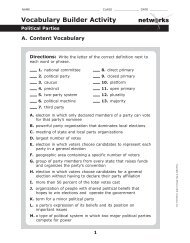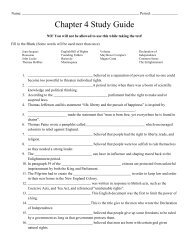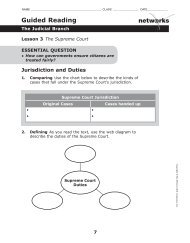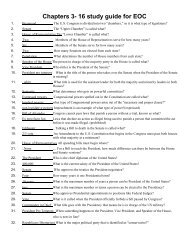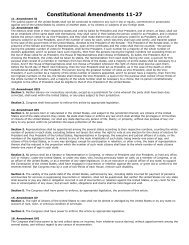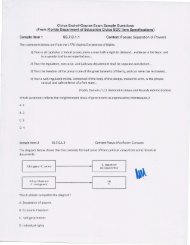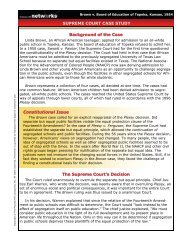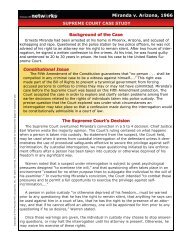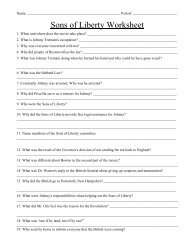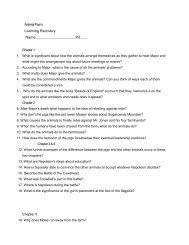M/J Civics Course Description Standards
M/J Civics Course Description Standards
M/J Civics Course Description Standards
- No tags were found...
You also want an ePaper? Increase the reach of your titles
YUMPU automatically turns print PDFs into web optimized ePapers that Google loves.
M/J <strong>Civics</strong> <strong>Course</strong> <strong>Description</strong> <strong>Standards</strong>SS.7.C.1.1 Recognize how Enlightenment ideas including Montesquieu’s view of separationof powers and John Locke’s theories related to natural law and how Locke’s social contractinfluenced the Founding Fathers.SS.7.C.1.2 Trace the impact that the Magna Carta, English Bill of Rights, MayflowerCompact, and Thomas Paine’s Common Sense had on colonists’ views of government.SS.7.C.1.3 Describe how English policies and responses to colonial concerns led to the writingof the Declaration of Independence.SS.7.C.1.4 Analyze the ideas (natural rights, role of the government) and complaints set forthin the Declaration of Independence.SS.7.C.1.5 Identify how the weaknesses of the Articles of Confederation led to the writing ofthe Constitution.SS.7.C.1.6 Interpret the intentions of the Preamble of the Constitution.SS.7.C.1.7 Describe how the Constitution limits the powers of government through separationof powers and checks and balances.SS.7.C.1.8 Explain the viewpoints of the Federalists and the Anti-Federalists regarding theratification of the Constitution and inclusion of a bill of rights.SS.7.C.1.9 Define the rule of law and recognize its influence on the development of theAmerican legal, political, and governmental systems.SS.7.C.2.1 Define the term “citizen,” and identify legal means of becoming a U.S. citizen.SS.7.C.2.2 Evaluate the obligations citizens have to obey laws, pay taxes, defend the nation,and serve on juries.SS.7.C.2.3 Experience the responsibilities of citizens at the local, state, or federal levels.SS.7.C.2.4 Evaluate rights contained in the Bill of Rights and other amendments to theConstitution.SS.7.C.2.5 Distinguish how the Constitution safeguards and limits individual rights.SS.7.C.2.6 Simulate the trial process and the role of juries in the administration of justice.SS.7.C.2.7 Conduct a mock election to demonstrate the voting process and its impact on aschool, community, or local level.SS.7.C.2.8 Identify America’s current political parties, and illustrate their ideas aboutgovernment.SS.7.C.2.9 Evaluate candidates for political office by analyzing their qualifications,experience, issue-based platforms, debates, and political ads.SS.7.C.2.10 Examine the impact of media, individuals, and interest groups on monitoring andinfluencing government.SS.7.C.2.11 Analyze media and political communications (bias, symbolism, propaganda).SS.7.C.2.12 Develop a plan to resolve a state or local problem by researching public policyalternatives, identifying appropriate government agencies to address the issue, and determininga course of action.SS.7.C.2.13 Examine multiple perspectives on public and current issues.SS.7.C.2.14 Conduct a service project to further the public good.SS.7.C.3.1 Compare different forms of government (direct democracy, representativedemocracy, socialism, communism, monarchy, oligarchy, autocracy).
SS.7.C.3.2 Compare parliamentary, federal, confederal, and unitary systems of government.SS.7.C.3.3 Illustrate the structure and function (three branches of government established inArticles I, II, and III with corresponding powers) of government in the United States asestablished in the Constitution.SS.7.C.3.4 Identify the relationship and division of powers between the federal governmentand state governments.SS.7.C.3.5 Explain the constitutional amendment process.SS.7.C.3.6 Evaluate constitutional rights and their impact on individuals and society.SS.7.C.3.7 Analyze the impact of the 13th, 14th, 15th, 19th, 24th, and 26 th amendments onparticipation of minority groups in the American political process.SS.7.C.3.8 Analyze the structure, functions, and processes of the legislative, executive, andjudicial branches.SS.7.C.3.9 Illustrate the lawmaking process at the local, state, and federal levels.SS.7.C.3.10 Identify sources and types (civil, criminal, constitutional, military) of law.SS.7.C.3.11 Diagram the levels, functions, and powers of courts at the state and federal levels.SS.7.C.3.12 Analyze the significance and outcomes of landmark Supreme Court casesincluding, but not limited to, Marbury v. Madison, Plessy v. Ferguson, Brown v. Board ofEducation, Gideon v. Wainwright, Miranda v. Arizona, In re Gault, Tinker v. DesMoines, Hazelwood v. Kuhlmeier, United States v. Nixon, and Bush v. Gore.SS.7.C.3.13 Compare the constitutions of the United States and Florida.SS.7.C.3.14 Differentiate between local, state, and federal governments’ obligations andservices.SS.7.C.4.1 Differentiate concepts related to U.S. domestic and foreign policy.SS.7.C.4.2 Recognize government and citizen participation in international organizations.SS.7.C.4.3 Describe examples of how the United States has dealt with international conflicts.SS.7.E.1.1 Explain how the principles of a market and mixed economy helped to develop theUnited States into a democratic nation.SS.7.E.1.2 Discuss the importance of borrowing and lending in the United States, thegovernment’s role in controlling financial institutions, and list the advantages and disadvantagesof using credit.SS.7.E.1.3 Review the concepts of supply and demand, choice, scarcity, and opportunity costas they relate to the development of the mixed market economy in the United States.SS.7.E.1.4 Discuss the function of financial institutions in the development of a marketeconomy.SS.7.E.1.5 Assess how profits, incentives, and competition motivate individuals, households,and businesses in a free market economy.SS.7.E.1.6 Compare the national budget process to the personal budget process.SS.7.E.2.1 Explain how federal, state, and local taxes support the economy as a function of theU.S. government.SS.7.E.2.2 Describe the banking system in the United States and its impact on the moneysupply.SS.7.E.2.3 Identify and describe U.S. laws and regulations adopted to promote economiccompetition.
SS.7.E.2.4 Identify entrepreneurs from various gender, social, and ethnic backgrounds whostarted a business seeking to make a profit.SS.7.E.2.5 Explain how economic institutions impact the national economy.SS.7.E.3.1 Explain how international trade requires a system for exchanging currency betweenand among nations.SS.7.E.3.2 Assess how the changing value of currency affects trade of goods and servicesbetween nations.SS.7.E.3.3 Compare and contrast a single resource economy with a diversified economy.SS.7.E.3.4 Compare and contrast the standard of living in various countries today to that of theUnited States using gross domestic product (GDP) per capita as an indicator.SS.7.G.1.1 Locate the fifty states and their capital cities in addition to the nation’s capital on amap.SS.7.G.1.2 Locate on a world map the territories and protectorates of the United States ofAmerica.SS.7.G.1.3 Interpret maps to identify geopolitical divisions and boundaries of places in NorthAmerica.SS.7.G.2.1 Locate major cultural landmarks that are emblematic of the United States.SS.7.G.2.2 Locate major physical landmarks that are emblematic of the United States.SS.7.G.2.3 Explain how major physical characteristics, natural resources, climate, andabsolute and relative location have influenced settlement, economies, and inter-governmentalrelations in North America.SS.7.G.2.4 Describe current major cultural regions of North America.SS.7.G.3.1 Use maps to describe the location, abundance, and variety of natural resources inNorth America.SS.7.G.4.1 Use geographic terms and tools to explain cultural diffusion throughout NorthAmerica.SS.7.G.4.2 Use maps and other geographic tools to examine the importance of demographicswithin political divisions of the United States.SS.7.G.5.1 Use a choropleth or other map to geographically represent current informationabout issues of conservation or ecology in the local community.SS.7.G.6.1 Use Geographic Information Systems (GIS) or other technology




